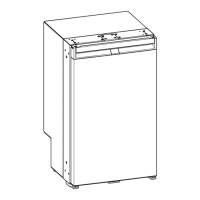16 4445103629
Usage conforme
Le réfrigérateur est adapté à ce qui suit :
• Installation dans les caravanes, les camping-
cars, les navires et les camions
• Réfrigération et stockage d’aliments
• NRX0035–0130(C/T) et NRX1035–1130(S)
uniquement : Stockage d’aliments surgelés
Ce réfrigérateur n’est pas destiné à une utilisation
commerciale, de vente au détail ou domestique.
Le réfrigérateur n’est pas conçu pour :
• Le stockage de médicaments
• Le stockage de substances corrosives ou conte-
nant des solvants
• La surgélation d’aliments
Le compartiment de congélation convient pour le
stockage des produits précongelés et pour le stoc-
kage ou la préparation de glaces et de glaçons. Il
n’est pas adapté à la congélation d’aliments pré-
cédemment décongelés.
Le réfrigérateur est destiné à être installé dans un
meuble ou une cavité dédiée.
Ce produit convient uniquement à l’usage et à
l’application prévus, conformément au présent
manuel d’instructions.
Ce manuel fournit les informations nécessaires à
l’installation et/ou à l’utilisation correcte du pro-
duit. Une installation, une utilisation ou un entre-
tien inappropriés entraînera des performances
insatisfaisantes et une éventuelle défaillance.
Le fabricant décline toute responsabilité en cas de
blessure ou de dommage résultant :
• d’un montage ou d’un raccordement incorrect,
y compris d’une surtension
• d’un entretien inadapté ou de l’utilisation de
pièces de rechange autres que les pièces de
rechange d’origine fournies par le fabricant
• de modifications apportées au produit sans
autorisation explicite du fabricant
• d’usages différents de ceux décrits dans ce
manuel.
Dometic se réserve le droit de modifier l’appa-
rence et les spécifications produit.
Utilisation
Procédez comme indiqué :
• Informations relatives au stockage des aliments :
fig. 1, page 4
• Ouverture de la porte du réfrigérateur : fig. 2,
page 4
• Fermeture et sécurisation de la porte du
réfrigérateur : fig. 3, page 4
• Mise en marche et arrêt : fig. 4, page 5
• Réglage des modes de fonctionnement :
fig. 5, page 5
• Réglage de la puissance frigorifique : fig. 6,
page 6
• Repositionnement des clayettes : fig. 7,
page 6 à fig. 8, page 7
• Retrait du compartiment congélation : fig. 9,
page 7
• Installation de l’adaptateur CA/CC
(accessoires) : fig. 0, page 8.
Garantie
Consultez les sections ci-dessous pour de plus
amples informations relatives à la garantie et l’assis-
tance dans le cadre de la garantie aux États-Unis,
au Canada et dans toutes les autres régions.
États-Unis et Canada
GARANTIE LIMITÉE DISPONIBLE SUR
DOMETIC.COM/WARRANTY.
POUR TOUTE QUESTION OU POUR OBTENIR
UNE COPIE GRATUITE DE LA GARANTIE LIMITÉE,
CONTACTEZ :
DOMETIC CORPORATION
CENTRE D’ASSISTANCE CLIENT MARINE
2000 NORTH ANDREWS AVENUE
POMPANO BEACH, FLORIDE, ÉTATS-UNIS
33069
1-800-542-2477
Toutes les autres régions
La période de garantie légale s’applique. Si le pro-
duit s’avérait défectueux, veuillez vous adresser à
la succursale du fabricant située dans votre région
(dometic.com/dealer) ou à votre revendeur.

